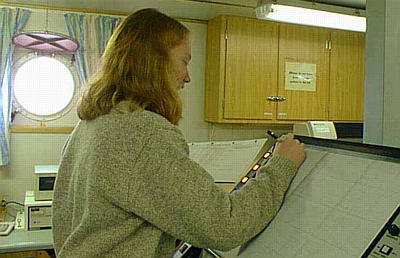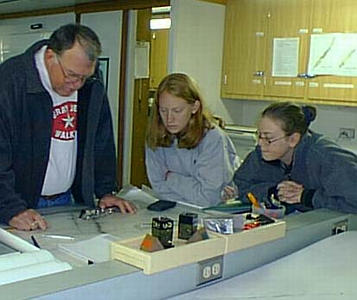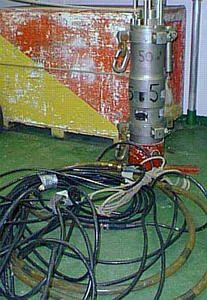17 February, 1999
February 17, 1999
Hi from the Nathaniel B. Palmer! When I woke up this morning, I noticed that
the ship was only traveling at about 5 knots, rather than the 10-12 we have
been averaging. Do you know what knots stands for? It means nautical miles
per hour, and one nautical mile is equal to one minute of latitude or about
1.1
miles. When I turned on my television monitor to find out why we were
going so
slowly, I realized that we were towing a seismic gun and streamer. We call it
shooting seismics. This process uses sound waves to determine the large-scale
vertical profile of the sediments. Behind the ship, we tow a huge "air gun"
and a long flexible tube (called a streamer). The "air gun" shoots out a
large
bubble of air, which creates a compressional wave. When this happens, a loud
pop is created and those waves travel down to the ocean floor. Some waves
bounce off the surface of the sediments, but others bounce off specific layers
of sediments beneath the surface. The streamer contains things called
transducers (we call them phones) in it that listen for the return of the
sound
waves and record how long they take to get there. In the dry lab, we have a
computer monitor that records this information and we have a printer that
makes
a printout of what the seafloor (and the layers beneath) looks like. We are
specifically looking at the top 250 meters of sediments with this instrument
(although it penetrates much deeper). Other scientists may use much larger
guns to penetrate all the way down to the earth's mantle! The line that we
are
"shooting" is nearly 28 hours long and it extends across the Ross Sea from the
continental shelf break (where the slope quickly descends down to the deepest
parts of the ocean) to the Ross Ice Shelf . . . about 140 miles towards the
land.
Let's take a few minutes to look at yesterday's question: "How tall is the ice
sheet, and how did it form?" The ice sheet is the large mass of ice and snow
that covers most of the Antarctic continent. Many sources describe Antarctica
as being 98% covered by ice. Newer satellite images, however, show that ice
covers 99.6% of the continent. Antarctica's ice sheets contain 90% of the
world's ice and are said to contain between 70-85% of the world's fresh water.
Because Antarctica is the driest continent on Earth, the amount of snow
deposited in any one year is relatively low. But Antarctica is also very
cold,
so the snow has accumulated over many thousands of years without melting. As
snow is deposited year after year in the interior of the ice sheet, it
consolidates to form ice. The ice sheet averages over a mile thick, and it is
almost 3 miles thick in some places. You can imagine that the weight of that
much ice is very great. As a result of pressure created by the weight of the
ice sheet, the ice flows from the high interior of the continent towards the
lower Antarctic coast. At the coast, large pieces break off the ice sheet to
form icebergs. In some areas, the ice sheet slides off the land and floats on
the water . . . which is an ice shelf (like we talked about on Feb. 14th). In
slightly warmer climates, ice is removed from ice sheets mostly by melting.
Only in a polar setting such as Antarctica is the calving of icebergs the
major
way that ice is removed from the ice sheet. (Do you remember the term
“ablation?”)
The Antarctic ice sheet has two parts -- the East Antarctic Ice Sheet and the
West Antarctic Ice Sheet. The East Antarctic Ice Sheet is more stable than
the
West Antarctic Ice Sheet. This is because the land beneath the East Antarctic
Ice Sheet is almost entirely above sea level. This is called a "land-based"
ice sheet. Land-based ice sheets are believed to be very stable and react very
slowly to changes in the environment. The West Antarctic Ice Sheet,
however, is
considered a "marine-based" ice sheet. This means that the base of the ice
sheet sits on rocks that are mostly below sea level. In some locations, the
West Antarctic Ice Sheet rests on rock over one mile below sea level.
Polar ice sheets are considered stable as long as the amount of ice that is
added to an ice sheet by precipitation equals the amount of ice that is
removed
by making icebergs. In marine-based ice sheets, it is easier to upset that
balance and lose more material than is gained -- which causes the ice sheet to
break down. Marine-based ice sheets can be affected by many different
factors,
including the flow speed of the ice and the temperature of the ocean. Ice
shelves form a direct connection to the ocean and they are an easy way for the
ice to thin and break apart on a marine-based ice sheet. A few days ago, we
discussed the disintegration of some ice shelves near the Antarctic
Peninsula.
Researchers are currently studying the West Antarctic Ice Sheet to predict its
future stability.
In fact, our research here in Antarctica is a small part of the WAIS
Initiative
(West Antarctic Ice Sheet). The WAIS Initiative is a collaborative study by
researchers from many fields of discipline and from many different
universities. There are some estimates that the West Antarctic Ice Sheet
could
collapse within the next 1000 years and cause sea levels to rise as much as 20
feet. Scientists want to have a clear understanding of ice sheets in order to
understand what is happening today and predict what will happen in the
future.
There are two theories, or models, for this. One is that the ice sheet will
collapse in a relatively short period of time, and the other is that the ice
sheet will retreat very slowly. Our research is looking at features on the
sea
floor to determine how the ice sheet behaved in the past (since the last
glacial maximum, approximately 20,000 years ago). Scientists believe that if
they can determine how the ice sheet behaved in the past, they may be able to
predict how it will behave in the future.
Tomorrow, we'll look at some of the other pieces of equipment that we use to
study the sea floor. Do you know how sonar works? We sure depend on it a
lot. See you the next time!
Kim Giesting
Latitude: 77 degrees 41 minutes South
Longitude: 168 degrees 43 minutes West
Temperature: -6.5 degrees C

Ashley is marking the seismic printout with the time, latitude, longitude, and water depth.

Dr. Anderson, Ashley, and PJ are looking at a map of the Ross Sea.

The seismic gun and streamer are sitting in the wet lab.
Contact the TEA in the field at
.
If you cannot connect through your browser, copy the
TEA's e-mail address in the "To:" line of
your favorite e-mail package.
|
